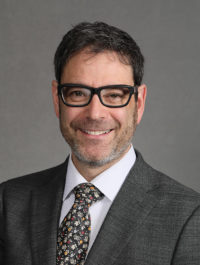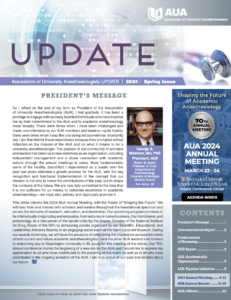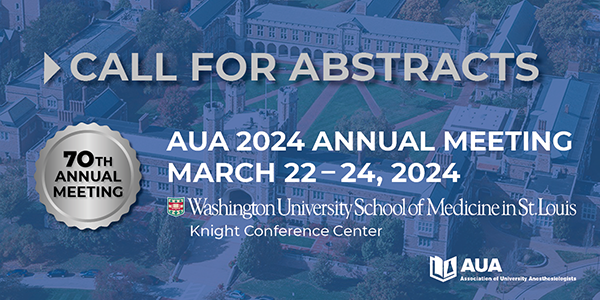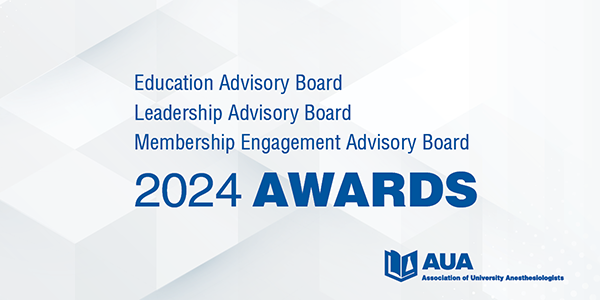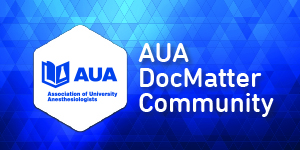President’s Message
The Association of University Anesthesiologists (AUA) is an honorific organization, which provides a home to leaders in academic anesthesiology. Although it is honorific, then AUA is also actively engaged in activities intended to safeguard anesthesiology as a dynamic academic medical specialty, with a vibrant community of successful scientific, educational and medical leaders. One cardinal new goal that the AUA is embracing, is leadership development within our field. As part of this focus, the AUA is prioritizing the mentorship of rising academics in anesthesiology, and support of initiatives such as the early stage anesthesiology scholars (eSAS).
For anesthesiology to continue to flourish as a vibrant medical specialty, it is essential that as a field we contribute meaningfully to science and knowledge generation; that we help train tomorrow’s academic leaders and scientists; that we are trailblazers in the education of medical students, residents, fellows and other clinicians; that we deliver outstanding, innovative and efficient preoperative assessment and optimization, perioperative care, pain management, critical care, and peripartum care; and that we collaborate with leaders in other specialties in transforming healthcare and in driving innovation. Within the context of the challenges and shifting priorities in medicine, the leadership of the Association of University Anesthesiologists held a strategic planning session at which we revisited the Vision and Mission of the AUA, and mapped out the priorities for the AUA over the next few years.
I presented the suggested new Vision and Mission Statements of the AUA at our business meeting in Montreal this year, and there was fruitful discussion and constructive suggestions. Several AUA members subsequently helped to refine these Statements further. It was agreed at the business meeting that the modified Vision and Mission Statements of the AUA would be included in a newsletter and would also be presented to the AUA membership for endorsement via an electronic ballot. We plan to follow these steps.
The proposed Vision and Mission Statements of the AUA are presented below. Many AUA members have helped to craft these, and I believe that they capture both the spirit of our association as well as the zeitgeist in academic medicine and healthcare. I hope that all AUA members will enthusiastically endorse and embrace these Statements.
The Vision of the Association of University Anesthesiologists (AUA) is the advancement of academic anesthesiology as a dynamic specialty that makes substantive contributions to medicine, science, and society.
The Mission of the AUA is to promote excellence in academic anesthesiology through
- mentorship of academics in anesthesiology;
- promotion of diversity and inclusion in academic anesthesiology;
- facilitation of professional growth throughout the careers of educators, academic leaders, and researchers in anesthesiology;
- organization of an outstanding annual meeting and provision of networking opportunities to academics in anesthesiology.
Apart from drafting new Mission and Vision Statements, we discussed strategic priorities and elaborated action items that should be implemented in order for us to progress meaningfully towards our aspirational goals. These items are summarized as follows:
- The AUA membership will vote on the proposed updated Vision and Mission Statements.
- The EAB and SAB should look at how the meeting furthers the revised mission of the organization. The meeting should be reconceptualized according to our new Mission and Vision.
- The AUA should solicit input from academic anesthesiology Chairs to define key attributes and skills of a leader in academic anesthesiology, in order to inform changes in the meeting that will cater towards leadership development.
- There should be a leadership meeting including the IARS, AUA, and FAER. The purpose for such a meeting would be to consider how these organizations can best collaborate and provide complementary service to academic anesthesiology.
- The AUA Council will create a working group with representation from the Council, eSAS, EAB, SAB, and also “LAB” (Leadership Advisory Board) for 2020.
- The council will revisit the associate membership requirements and will add an associate member to the council. An associate member will also be added to the meeting planning groups.
- The Council needs to clarify criteria for educational admittance to the membership. There should be well defined and publicized criteria for educational scholarship.
- The Council will explore developing relationships with other comparable honorific organizations in other medical specialties.
I believe that there is today tremendous energy, excitement and opportunity in academic anesthesiology. This is an important time for the AUA to provide leadership and to inspire and mentor tomorrow’s leaders. I hope that many of you will embrace the challenges and will work with us to strengthen anesthesiology as a vibrant scientific specialty. I sincerely thank all members of the SAB and EAB, as well as the hard working and dedicated AUA Council members for your time and contributions. I look forward to seeing you all at the AUA meeting on May 14th, 2020 in San Francisco.
